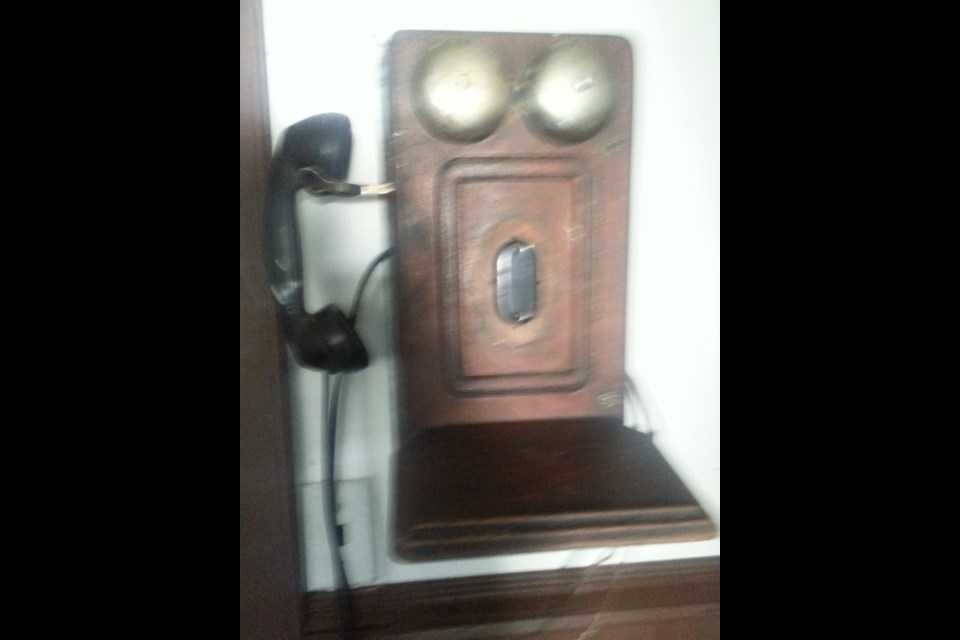BRESAYLOR — On April 3, 1917, 30 ratepayers met to organize the Bresaylor Rural Telephone Company. A tender was given out and accepted for T.W. Brown of Saskatoon for material and construction at $9,875 for telephones, lines and office installation. Another contract was drawn up with D.C. Foster & Company to operate the service from 8 a.m. to 8:30 p.m. weekdays and 9:10 a.m. to 6:30 p.m. Sundays at $4 per telephone per year and $2 per telephone per year for a repairman.
In 1918 the board applied for long distance connection, and six more plugs for the switchboard were ordered.
The early telephone system was different than it is today. A telephone wire was strung on poles leading to each farmyard, with as many as many as six households per line. The telephone consisted of a fancy wooden box mounted on the wall with two bells near the top, a crank on the side, a speaker in the centre and a receiver on a hook on the side. When you wanted to phone, you unhooked the receiver, which was on a cable, and held it to your ear to hear if someone else was talking on the line. If not, you would turn the crank on the side to ring out. Everyone on the line had their own ring. Your ring might be one long and two short rings and your neighbour’s ring might be two long rings and one short or any combination. You would turn the crank on the side a short time for a short ring and a longer time for a long ring. This would ring on every telephone on your line and hopefully just the neighbour you were calling lifted the receiver and no other neighbours listened in. To talk, you had to stand up to the telephone to talk into the mouthpiece.
If you had to call someone on a different line, you turned the crank one short ring and the switchboard operator would answer. You would tell the operator who you wanted to call and they would connect you to that line and ring the person for you.
When the community had an announcement to make such as a funeral, auction sale, meeting, or other activity the operator would connect all the lines and put through a single ring. Everyone would lift the receiver to their ear and the operator would read the announcement.
On later telephones, the speaker in the centre front of the telephone was replaced by a speaker and receiver put together and attached to the side of the telephone by a cable, so you no longer had to stand directly in front of the telephone to talk.
Shareholders voted in 1951 to amalgamate with Paynton, and in 1952, they amalgamated and connected to the Paynton switchboard. Bresaylor switchboard was then closed.
In 1968, the direct dial system was introduced. The direct dial telephone was much smaller and could sit on a desk. It had a circular wheel on the front with numbers 0 to 9 that you would use to dial out. By 1970, Paynton had joined SaskTel and overhead lines were replaced by underground lines.
The Bresaylor Museum’s annual potluck supper will be held on Sunday, July 24, at 5 p.m. Guest speaker will be indigenous historian and film maker Floyd Favel, who will speak about Chief Poundmaker and his relationship with the Bresaylor settlers. Favel is the curator of the Poundmaker Museum and director of Miyawata Culture which hosts the Poundmaker Performance Festival. He will also be signing his new book The Story of Broken Knife Lookout. Bring lawn chairs and some food to share. Take a tour of the museum and enjoy an evening of visiting.
Tours of the Bresaylor Heritage Museum are available from June 30 to Aug. 31 by appointment only. Please phone Enola at 306-893-8002 or Bob at 306-895-2075 to arrange a guided tour by one of our volunteer staff. Check out the Bresaylor Heritage Museum Facebook page for more information.




